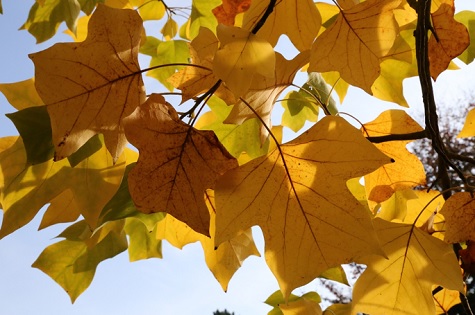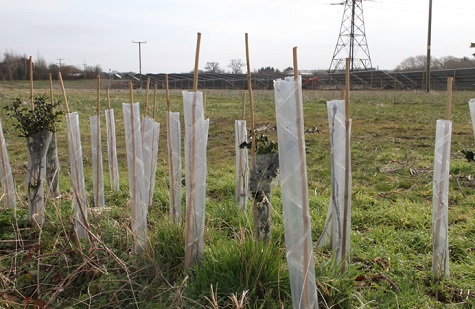We are starting to see a change in the weather. Last week we saw significant changes in both soil and air temperatures, dropping down into single figures. This was coupled with clear, cloudless nights that brought about the appearance of some early morning dews and frosts.
Dew forms when a surface cools to a temperature which is colder than the air next to the surface. Dew is water that has condensed from some of the water vapour contained in the air. If the layer of air next to the ground were actually cooling, then fog would form. Instead, it is just the surface (for instance, grass) that is cooling, and a very thin layer of air next to the grass deposits some of its water vapour on the grass.

Fungal disease
The combination of early morning dews, warm and wet weather and diminishing daylight hours increases the risk of fungal disease outbreaks. The right conditions to trigger these disease attacks are weakened or susceptible plants, a disease-producing organism (pathogen usually fungi) and weather conditions which favour the formation of fruiting bodies and spores (moist, mild wet conditions).
Most diseases that are occurring now have responded to the unusually warm, autumn weather conditions. Boundary layers around the leaves have stayed very moist and humid. Relative humidity is important for spore germination and penetration of leaf tissues, and constant wet conditions will allow the development and transportation of active fungi spores.
Most fungi grow well between 10°C - 40°C and function best at a pH range of 4-7pH. The current lack of cooler weather and sharp frosts has not helped in reducing these active pathogens.
The first step in turfgrass disease management is identifying the true nature of the problem and then carrying out some maintenance tasks to reduce the incidence of these diseases.
The pathogens that cause these diseases are always lying dormant, waiting for the ideal conditions to become active. Once these spores are activated, and have found an appropriate host, they are able to grow and reproduce themselves, spreading new spores and infections to other areas of turf. This cycle continues whilst favourable conditions prevail.
Understanding and implementing works that can break up the disease cycle will help reduce the opportunities for disease development and outbreak.

When it comes to disease identification, there is as much emphasis on you, as the turf manager, to provide appropriate turf samples for analysis as there is for the lab to accurately identify the problem. In most cases, the best place to remove a turf sample for analysis is from the leading edge of the symptoms, where the affected or discoloured plants give way to healthy turf.
It is also important for the lab to be able to see what the general composition and condition of the sward is like and what the rootzone profile is like and, for those reasons, a 90mm diameter core sample, taken to a depth of approximately 60mm using a golf hole changer (or similar) makes for an ideal sample.
If possible, email photographs of the symptoms so that the lab can get an idea of how the problem is developing - a good picture can often tell so much more than a detailed written description.
There are several excellent laboratories that offer disease recognition, along with some good weather services that offer disease watch forecasts.
Common diseases that can be active and cause concerns at this time of the year are Red Thread, Fusarium and Dollar Spot.
However, the best mode of action is a preventative one, which will see you carry out the relevant cultural practices to break the cycle of the disease. Brushing to reduce dew deposits, good aeration and feeding programmes will help prevent and hopefully, reduce the incidence of diseases in your turf.

This autumn period (October – November) will also see us having to cope with the job of raking up and removing leaf debris from lawns, grass and sports playing surfaces. Luckily, this back-breaking work has been made easier with the development of a range of hand held, tractor and dedicated leaf sweepers, blowers and vacuums.
In fact, I am currently testing two STIHL backpower blowers, the BR450 C-EF model and their battery powered BGA200, for inclusion in a comparison test for an upcoming feature.
I already have my own BG56-C model which I use daily and is probably my most used piece of equipment to keep surfaces clean and tidy.
With the grass cutting season coming to a close, it is now time to turn your attention to and start -planning any relevant winter work projects. This generally centres around a number of annual jobs such as ditch and pond clearance, pathway and tree works, drainage work and landscape planting work or new construction works .
Tree work
For me, one of the most important jobs is to carry out any relevant tree works. This may be a programme of tree felling, tree pruning (crown lifting, reducing) or tree planting. However, the most challenging of these tasks is the choice selection and planting of new tree material.

Planting trees and hedges should not be looked at in terms of being a chore, or that it may be too expensive. Planting trees and hedges is about leaving a lasting legacy for future generations to enjoy and benefit from.
Many factors must be taken into consideration when planting trees and hedges. First and prior to any planting, think carefully about what you are trying to achieve.
The choice of planting material will need to be carefully considered. Should it be a single species, deciduous or evergreen, or a mixture? Should they be flowering or non-flowering, thorny or smooth barked?
It is also important to choose the right plant for the right place; the topography and environmental factors of the site will dictate what can be planted and where.

The condition and age of the plant material is vitally important in terms of dictating both the successful establishment and how quickly you want the hedge or tree to achieve its objective.
However today, with so much more user friendly accessories available to aid planting when excavating, staking, feeding and watering, the job of hedge and tree planting has been made much easier and more flexible.
Also the array of machinery now on offer to aid planting and cultivation is immense; rotavators, trenchers and small diggers are relatively cheap and, in most cases, may be hired. We have also seen the introduction of tree spades that are able to remove and replant large trees.
Always source material from reliable nurseries and ensure it is true to cultivar/species and in good health. In recent years, a lot of imported nursery stock has been blighted with disease; the recent ash die back disease being a prime example. This has affected the supply of many trees in the UK in recent months, with nurseries having to dispose and burn their stocks to prevent its spread.
Tree and hedge aftercare
Ensure that all tree ties are kept secure but not too tight, and that no grass or weeds are allowed to grow around the plants for at least a year. Invest in good robust materials and choose the best means to secure and protect your hedge and trees.
There are several methods for staking trees depending on their size - single, double and triple staking, short stakes, and cages. For hedges, which may need protection from rabbits and the wind, there are an array of products to choose from. The success of any planting scheme is often determined by how well they have been protected and maintained.
Aftercare should not be forgotten. Regularly inspect your plantations, hedges and trees. Set yourself up with a long term maintenance plan. The first ten years are crucial and you will be surprised how quickly time passes by.
Far too often, I still see some standard tree planting schemes still having their support stakes left on after more than ten years, Most tree stakes should be removed after 24 months of planting , the tree should be capable of supporting itself by then.
Also consider feeding the tree, there are a number of fertiliser products on the market that you apply beneath the canopy of the tree. Also, if there is a lot of foot traffic, the ground may become compacted, therefore some light aeration work around the base of the tree would be beneficial.